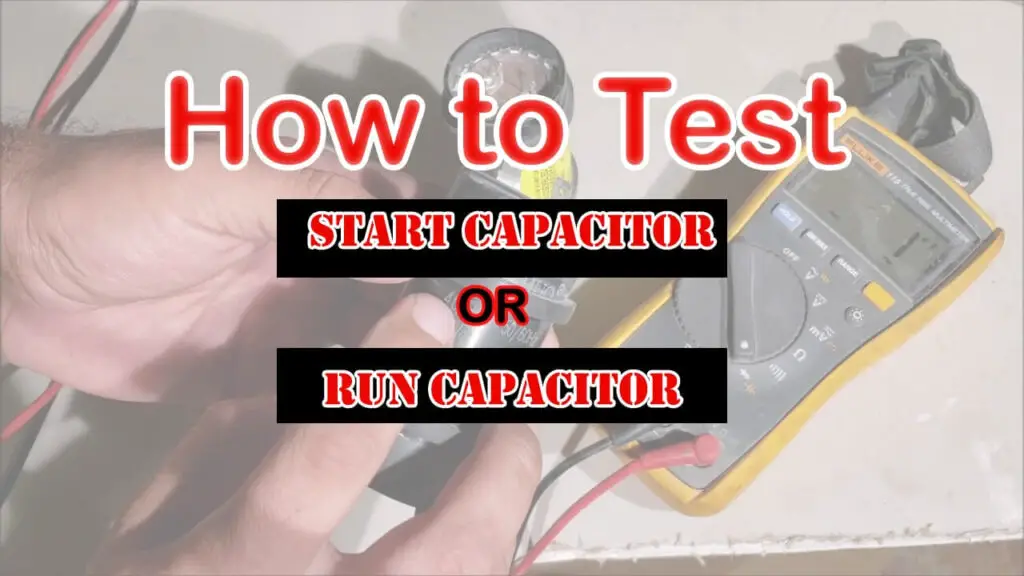How to test a Run or a Start Capacitor
I am using Fluke 115 digital multimeter. It gives you perfect charge and discharges capacitor readings. I am testing start and run capacitors for single-phase electric motors 110-220 volts; air conditioners, air compressors, washers’ dryers that’s what we are telling you in this article.
How to test a start and a run capacitor of an air compressor 110 volts
Therefore, I am testing a 110-volt air compressor:
It has two capacitors; one is a start and another one is a running capacitor. So, I am using the washing machine motor that has a cover, and when you take the lid off you may see the capacitor. It is hiding out back there. There is a point to locate your capacitor. When you find your capacitor; this is quite dangerous; it can give you an electric shock.
Note:
It would be best if you took an insulated handle screwdriver to touch the two terminals together. Work carefully because this can give an electric shock to you. And if you’re on the concrete ground. The A/C current is seeking the ground, and that’s how people die by electrocution or get shocked and burned up bad.

Table of Contents
Test 1: The first way to test a Running Capacitor
I am using Fluke 115 digital multi-meter to test the correct way to test a running capacitor. Place the meter dial to farads the sign is like this; ₸.
I am taking out the capacitor of an air compressor, by using an insulated screwdriver, we touched both the ends of the terminals of the testing capacitor to discharge it and then touch both the leads of the multimeter to the terminals it gives you the reading of 247uF micro-Farads.
Do it again and again by flipping the terminals the reading is 247uF. And the value written over the body of the terminal is 250uF. That means the capacitor is working in good condition. This is the best way to test a running capacitor.
Test 2: The second way to test a Running Capacitor
When you find your capacitor; this procedure to test a running capacitor is quite dangerous; it can give you an electric shock.
Precautions before the test:
It would be best if you took an insulated handle screwdriver to touch the two terminals together. Wear rubber hand gloves and eye protection glasses first. Work carefully because this can give an electric shock to you. And if you’re on the concrete ground. The A/C current is seeking the ground, and that’s how people die by electrocution or get shocked and burned up bad.
For the second test, I took a capacitor of a washer, and I need a plug-in socket to supply current to the capacitor and I used alligators at the end of the wire to connect the terminals of the capacitor. That is how we have completed our circuit. Now turn ‘ON’ the switch only for one second.
Be careful this should be on only for a second
Now with the help of the insulated screw touch both the terminals together, it will give you a big spark. By touching it again and again the capacitor will become discharged. This is the second way to test a running capacitor.
So that is why you need to be very careful with AC power. So, once you got the capacitor discharged, you know it’s well, then it’s safe to take the electric current wires off and get it out. After that, test this capacitor.
Now test the capacitor it gives the reading 423 but goes into minus to infinite. By flipping both the terminals to the test leads again it is giving the reading in minus again that’s why I don’t like this test, which is pointless.
Test 3: The third way to test a Running Capacitor
You have to get one meter like this FLUKE 115 DIGITAL METER because you are not going to, 100% be able to check the capacitor. This is the only digital meter compared to a clamp meter or analogue multimeter that gives you a correct reading.
We are taking a good condition capacitor, set the fluke meter settings to Ohms. And test the capacitor with the multimeter leads, the reading on the screen looks like that, so we got 233v to 280 volts, so that’s given us our range, so we have to be in that range for this to be a good capacitor, so what did we end up getting if we got 233v to 280v, shake it one more time 235v to 234v. The value written on the body of the capacitor is 240volts. So, this is showing the capacitor is in good condition.
What are the signs of a bad capacitor?
Any electrical component or electronic component has a bad capacitor:
- The bottom of the capacitor will show erosion.
- The second sign for the bad capacitor is, the digital multimeter will be showing the Ohm setting reading going up and down, showing charging and discharging of the capacitor.
- The capacitor is leaked.
- The teared body of the capacitor.
What is the difference between a start or a running capacitor?
Run Capacitor:
Run capacitors have a value in a range of 3–70 microfarad (uF). Running capacitors are also checked by voltage classification. The voltage classifications of a run capacitor measured are 370V and a440V.
Example: CBB65 Oil-filled Capacitors
ADP Dry-type Black Box Capacitors
CBB60B Dry-type Capacitors
Italfarad Dry-type Plastic Case Capacitors
Start Capacitor:
Start capacitors ratings are in 70 microfarads or if it is higher having three more voltage classifications: 125V, 250V, and 330V. These are used in household components. Like a 35 uF at 370V run capacitor and an 88–108 uF at 250V start capacitor.
Example: CD60B Aluminium Electrolytic Capacitors
How do you tell if a capacitor is bad with a multimeter?
- I am using Fluke 115 digital multimeter to test a bad capacitor.
- First, move the fluke dial to higher voltage Ohm’s settings.
- Now test the capacitor with multimeters leads.
- If the capacitor is showing a charging reading on a multimeter and it’s going to discharge it to zero.
- Suppose the reading is 129Volts of a capacitor and it is decreasing to zero.
- It means the capacitor is bad.
Frequently Asked Questions:
Usually, we use a run capacitor for household appliances, because it stores current and sends alternative current whereas a start capacitor is used to start air conditioners.
Start capacitor cannot be replaced with a run capacitor.
If the wrong size capacitor is used, the motor will not have an even magnetic field. This will cause the rotor to hesitate in uneven areas. This hesitation causes the motor to become noisy, increases energy consumption, reduces performance, and causes the motor to overheat.
Conclusion
We have explained the working and nonworking condition of a capacitor. For this purpose, we performed three different tests to understand the performance of a capacitor and also the procedure to test a run capacitor. we also, explained the signs of a bad condition capacitor that you can understand without testing it with a multimeter.
The difference between a start capacitor and a run capacitor. And also how do we know the reading of a multimeter is showing the capacitor is good or bad. we also shared the Frequently Asked Questions regarding start and run capacitors.
Related Posts:
How to test capacitor with the multimeter in circuit





